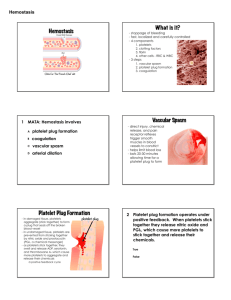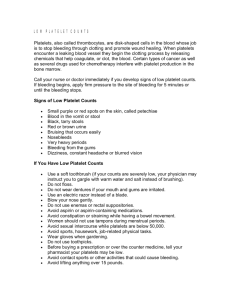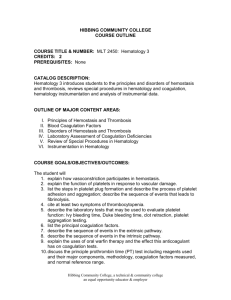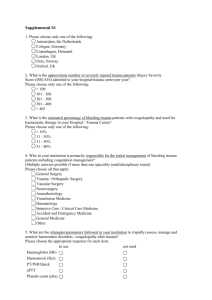An Overview of Hemostasis
advertisement
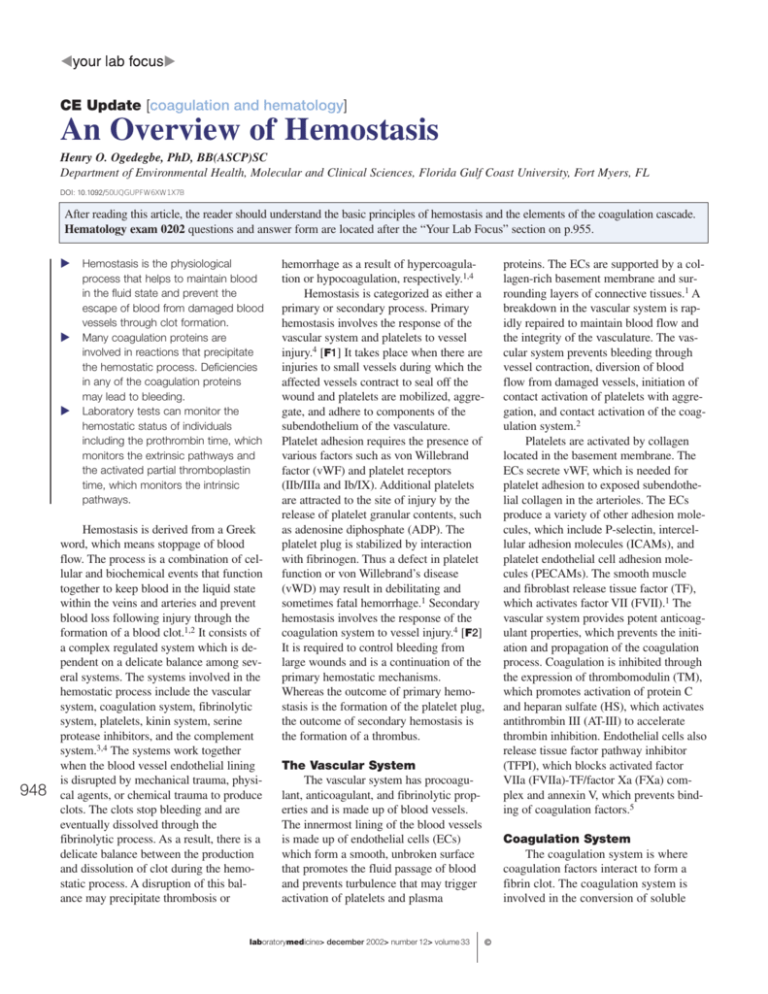
CE Update [coagulation and hematology] An Overview of Hemostasis Henry O. Ogedegbe, PhD, BB(ASCP)SC Department of Environmental Health, Molecular and Clinical Sciences, Florida Gulf Coast University, Fort Myers, FL DOI: 10.1092/50UQGUPFW6XW1X7B After reading this article, the reader should understand the basic principles of hemostasis and the elements of the coagulation cascade. Hematology exam 0202 questions and answer form are located after the “Your Lab Focus” section on p.955. 왘 Hemostasis is the physiological 왘 왘 948 process that helps to maintain blood in the fluid state and prevent the escape of blood from damaged blood vessels through clot formation. Many coagulation proteins are involved in reactions that precipitate the hemostatic process. Deficiencies in any of the coagulation proteins may lead to bleeding. Laboratory tests can monitor the hemostatic status of individuals including the prothrombin time, which monitors the extrinsic pathways and the activated partial thromboplastin time, which monitors the intrinsic pathways. Hemostasis is derived from a Greek word, which means stoppage of blood flow. The process is a combination of cellular and biochemical events that function together to keep blood in the liquid state within the veins and arteries and prevent blood loss following injury through the formation of a blood clot.1,2 It consists of a complex regulated system which is dependent on a delicate balance among several systems. The systems involved in the hemostatic process include the vascular system, coagulation system, fibrinolytic system, platelets, kinin system, serine protease inhibitors, and the complement system.3,4 The systems work together when the blood vessel endothelial lining is disrupted by mechanical trauma, physical agents, or chemical trauma to produce clots. The clots stop bleeding and are eventually dissolved through the fibrinolytic process. As a result, there is a delicate balance between the production and dissolution of clot during the hemostatic process. A disruption of this balance may precipitate thrombosis or hemorrhage as a result of hypercoagulation or hypocoagulation, respectively.1,4 Hemostasis is categorized as either a primary or secondary process. Primary hemostasis involves the response of the vascular system and platelets to vessel injury.4 [F1] It takes place when there are injuries to small vessels during which the affected vessels contract to seal off the wound and platelets are mobilized, aggregate, and adhere to components of the subendothelium of the vasculature. Platelet adhesion requires the presence of various factors such as von Willebrand factor (vWF) and platelet receptors (IIb/IIIa and Ib/IX). Additional platelets are attracted to the site of injury by the release of platelet granular contents, such as adenosine diphosphate (ADP). The platelet plug is stabilized by interaction with fibrinogen. Thus a defect in platelet function or von Willebrand’s disease (vWD) may result in debilitating and sometimes fatal hemorrhage.1 Secondary hemostasis involves the response of the coagulation system to vessel injury.4 [F2] It is required to control bleeding from large wounds and is a continuation of the primary hemostatic mechanisms. Whereas the outcome of primary hemostasis is the formation of the platelet plug, the outcome of secondary hemostasis is the formation of a thrombus. The Vascular System The vascular system has procoagulant, anticoagulant, and fibrinolytic properties and is made up of blood vessels. The innermost lining of the blood vessels is made up of endothelial cells (ECs) which form a smooth, unbroken surface that promotes the fluid passage of blood and prevents turbulence that may trigger activation of platelets and plasma laboratorymedicine> december 2002> number 12> volume 33 proteins. The ECs are supported by a collagen-rich basement membrane and surrounding layers of connective tissues.1 A breakdown in the vascular system is rapidly repaired to maintain blood flow and the integrity of the vasculature. The vascular system prevents bleeding through vessel contraction, diversion of blood flow from damaged vessels, initiation of contact activation of platelets with aggregation, and contact activation of the coagulation system.2 Platelets are activated by collagen located in the basement membrane. The ECs secrete vWF, which is needed for platelet adhesion to exposed subendothelial collagen in the arterioles. The ECs produce a variety of other adhesion molecules, which include P-selectin, intercellular adhesion molecules (ICAMs), and platelet endothelial cell adhesion molecules (PECAMs). The smooth muscle and fibroblast release tissue factor (TF), which activates factor VII (FVII).1 The vascular system provides potent anticoagulant properties, which prevents the initiation and propagation of the coagulation process. Coagulation is inhibited through the expression of thrombomodulin (TM), which promotes activation of protein C and heparan sulfate (HS), which activates antithrombin III (AT-III) to accelerate thrombin inhibition. Endothelial cells also release tissue factor pathway inhibitor (TFPI), which blocks activated factor VIIa (FVIIa)-TF/factor Xa (FXa) complex and annexin V, which prevents binding of coagulation factors.5 Coagulation System The coagulation system is where coagulation factors interact to form a fibrin clot. The coagulation system is involved in the conversion of soluble © fibrinogen, a major component of the acute inflammatory exudates into fibrin. The fibrin clot reinforces the platelet plug formed during primary hemostasis. Various protein factors present in the inactive state in the blood participate in the coagulation system [T1]. The protein factors are designated by Roman numerals according to their sequence of discovery and not by their point of interaction in the coagulation cascade.2 Some of the coagulation factors such as fibrinogen and prothrombin are referred to by their common names, whereas others such as factors VIII and XI are referred to by their Roman numeral nomenclatures. Activation of a factor is indicated by the addition of low case “a” next to the Roman numeral in the coagulation cascade such as VIIa, Xa, XIIa.2 Some of the common names were derived from the original patients in whom symptoms leading to the determination of the factor deficiency were found. Examples are the Christmas factor and Hageman factor. The coagulation factors may be categorized into substrates, cofactors, and enzymes. Fibrinogen is the main substrate. The cofactors accelerate the activities of the enzymes, which are involved in the coagulation cascade. Examples of cofactors include tissue factor, factor V, factor VIII, and Fitzgerald factor. With the exception of factor XIII, all the enzymes are serine proteases when activated.2 The coagulation factors may also be categorized into 3 groups on the basis of their physical properties. These groups are the contact proteins comprising of factors XII, XI, prekallikrein (PK), and high molecular weight kininogen (HMWK); the prothrombin proteins comprising of factors II, VII, IX, and X; and the fibrinogen or thrombin sensitive proteins comprising of factors I, V, VIII, and XIII.2 Fibrinolytic System Fibrinolysis is the physiological process that removes insoluble fibrin clots through enzymatic digestion of the cross-linked fibrin polymers. Plasmin is responsible for the lysis of fibrin into fibrin degradation products, which may Vessel spasm Vessel Injury Exposed Subendothelium vWF,GPIb,receptor,collagen Vessel Constriction Platelet adhesion & shape change ADP, TXA2, Colagen, Ca++, serotonin Thrombin Platelet activation & secretions, change shape (β- TB, PF3, PF4, PDGF, thrombospondin) Platelet aggregation (ATP, Fibrinogen, GPIIb, GPIIIa) Platelet plug formation Fibrin Meshwork Thrombus consolidation Fibrin clot construction vWF =von Willebrand’s factor ADP = Adenosine diphosphate TXA2 = Thromboxane β-TB = Beta-thromboglobulin PF4 = Platelet factor 4 PF3 = Platelet factor 3 PDGF = Platelet derived growth factor Fibrin polymerization [F1] The primary hemostatic plug formation have local effects on vascular permeability. Plasmin digests fibrin and fibrinogen through hydrolysis to produce smaller fragments. The gradual process occurs at the same time that healing is occurring, and eventually cells of the mononuclear phagocytic system phagocytize the particulate products of the hydrolytic digestion.6 Recent evidence suggest that the © renin-angiotensin-aldosterone system (RAAS) may participate in the regulation of fibrinolytic function.7 Angiotensin II (Ang II) is the primary candidate to mediate this interrelationship, since this peptide is capable of stimulating plasminogen activator inhibitor-1 (PAI-1) in vitro and in vivo. It has been suggested that aldosterone laboratorymedicine> december 2002> number 12> volume 33 949 Coagulation Factors 950 Factor Common Name Function Pathway Participation Factor I Fibrinogen Thrombin substrate, polymerizes to form fibrin Common Factor II Prothrombin Serine protease Common Factor III Tissue factor Cofactor Factor IV Ionic calcium Mineral Factor V Labile factor Cofactor Common Factor VII Stable factor Serine protease Extrinsic Factor VIII Antihemophiliac factor von Willebrand factor (vWF) Cofactor Intrinsic Factor IX Christmas factor Serine protease Intrinsic Factor X Stuart Prower factor Serine protease Common Factor XI Plasma thromboplastin antecedent (PTA) Serine protease Intrinsic Factor XII Hageman factor Serine protease Intrinsic Factor XIII Fibrin stabilizing factor Transglutaminase Common Prekallikrein Fletcher factor Serine protease Intrinsic High molecular weight kininogen Fitzgerald factor, HMWK Cofactor Intrinsic Platelet factor 3 Phospholipids, PF3 Assembly molecule may also modulate fibrinolysis, possibly by interacting with Ang II.7 Fibrinolysis is controlled by the plasminogen activator system. The proteolytic activity of this system is mediated by plasmin, which is generated from plasminogen by 1 of 2 plasminogen activators. Inactive plasminogen circulates in plasma until such a time that an injury occurs. Then, plasminogen is activated by means of a number of proteolytic enzymes known as plasminogen activators. These activators are present at various sites such as the vascular endothelium. Some of the activators include tissue-type plasminogen activator, urokinase, streptokinase, and acyl-plasminogen streptokinase activator complex. Inhibitors of fibrinolysis include α2- plasmin inhibitor, tissue plasminogen activator inhibitor, and plasminogen activator inhibitor-1 (PAI-1).6 Individuals with reduced fibrinolytic activity are at increased risk for ischemic cardiovascular events, and reduced fibrinolysis may underlie some of the pathological consequences of reduced nitric oxide (NO) availability.8 Platelets Platelets are anuclear fragments derived from the bone marrow megakaryocytes. They have a complex internal structure, which reflects their hemostatic functions. The 2 major intracellular granules present in the platelets are the α-granules and the dense bodies. The α-granules contain platelet thrombospondin, fibrinogen, fibronectin, platelet factor 4, vWF, platelet derived growth factor, β-thromboglobulin, and coagulation factors V and VIII. The dense granules contain ADP, adenosine triphosphate (ATP), and serotonin. When stimulated, platelets release both the α-granules and the dense bodies through the open canalicular system.14 When platelets aggregate, they expend their stored energy sources, lose their membrane integrity, and form an unstructured mass called a syncytium. In addition to the plug formation, platelet aggregates release micro-platelet membrane particles rich in phospholipids and various coagulation proteins which provide localized laboratorymedicine> december 2002> number 12> volume 33 T1 environment that support plasma coagulation.1 Platelets and ECs have biochemical pathways involving the metabolism of arachidonic acid (AA), which is released from membrane phospholipids by phospholipase A2. Subsequently, cyclooxygenase converts AA to cyclic endoperoxides. The endoperoxides are then converted by thromboxane synthetase to thromboxane A2. Thromboxane A2 is a potent agonist that induces platelet aggregation. Endothelial cells also contain AA and preferentially convert cyclic endoperoxides to prostacyclin, which is a potent inhibitor of platelet aggregation.9 During primary hemostasis, platelets interact with elements of the damaged vessel wall leading to the initial formation of the platelet plug. The platelet/injured vessel wall interaction involves a series of events that include platelet adhesion to components of the subendothelium, activation, shape change, release of platelet granules, formation of fibrin stabilized fibrin platelet aggregates, and clot retraction. In this process, the © activation of platelets with exposure of negatively charged phospholipids facilitates the assembly of coagulation factors on the activated platelet membrane, leading to the generation of thrombin and subsequent fibrin deposition.9 Platelet Function In some disorders, platelets may be normal in number, yet hemostatic plugs do not form normally, and therefore, bleeding time will be long. Platelet dysfunction may stem from an intrinsic platelet defect or from an extrinsic factor that alters the function of otherwise normal platelets. Defects may be hereditary or acquired. Tests of coagulation phase of hemostasis such as activated partial thromboplastin time (APTT) and prothrombin time (PT) are normal in most circumstances but not all.10 When a patient’s childhood history reveals easy bruising and bleeding after tooth extraction, tonsillectomy, or other surgical procedures, the finding of normal platelet count but a prolonged bleeding time suggests a hereditary disorder affecting platelet function. The cause is either vWD (which is the most common cause of hereditary hemorrhagic disease) or a hereditary intrinsic platelet disorder. Whatever the cause of platelet dysfunction, drugs that may further impair platelet function should be avoided such as aspirin and other non-steroidal antiinflammatory drugs (NSAIDs). Thrombocytopenia Thrombocytopenia may be the consequence of failed platelet production, splenic sequestration of platelets, increased platelet destruction, or dilution of platelets. Regardless of the cause, severe thrombocytopenia usually results in a typical pattern of bleeding such as multiple petechiae in the skin, scattered small ecchymoses at the sites of minor trauma, mucosal bleeding, and excessive bleeding after surgery. Heavy gastrointestinal (GI) bleeding and bleeding into the central nervous system (CNS) may be life threatening. However, thrombocytopenia does not cause massive bleeding into tissues, which is characteristic of bleeding secondary to coagulation disorders. Adult Intrinsic System Extrinsic System HMWK = High Molecular Weight Kininogen PF3 = Platelet factor 3 PL = Phospholipids [F2] The secondary hemostasis idiopathic thrombocytopenic puerperal (ITP) usually results from development of an antibody directed against a structural platelet antigen. In childhood ITP, viral antigen is thought to trigger synthesis of an antibody that may react with viral antigen associated with the platelet surface. Platelet count is usually maintained in a range of 150,000 to 400,000/µL and counts of 100,000 to 150,000/µL are regarded as borderline for thrombocytopenia while counts that are less than 100,000/µL are considered abnormal.11 Symptoms do not usually develop until the platelet count is less than 50,000, at which time easy bruising may be evident and petechiae may appear on the skin. Surgeons usually do not perform routine surgery on patients whose platelet counts are <50,000/µL because the risk of prolonged bleeding after dental proce- © dures or childbirth will be increased.11 When the platelet count reaches 10,000 to 20,000/µL, the risk of spontaneous and serious bleeding rises.11 This includes strokes, GI bleeding, and prolonged nose bleeds. When these conditions develop, platelet transfusions are often used to stop the bleeding. Unfortunately, transfused platelets are short-lived and cannot be used indefinitely as antibodies may develop against the platelets. Platelet transfusions are most appropriate when the cause of thrombocytopenia is a temporary lack of production such as after intensive chemotherapy. Kinin System The kinins are peptides of 9 to 11 amino acids of which the most important vascular permeability factor is bradykinin (BK). The kinin system is activated by laboratorymedicine> december 2002> number 12> volume 33 951 coagulation factor XII. Bradykinin is also a chemical mediator of pain, which is a cardinal feature of acute inflammation. Therefore, bradykinin is capable of reproducing many of the characteristics of an inflammatory state, such as changes in local blood pressure, edema, and pain, resulting in vasodilation and increased microvessel permeability.12 Human HMWK, a single-chain protein with a molecular weight of 120,000 daltons, is cleaved by human urinary kallikrein (HUK) to release kinin from within a disulfide loop and form a 2-chain protein that retains all the procoagulant activity of the native molecule.13 It is a multifunctional protein, a parent protein of bradykinin, and serves as a cofactor for FXI and PK assembly on biologic membranes. The docking of HMWK to platelet and EC membranes requires its binding by regions on both its heavy and light chains. 952 Serine Protease Inhibitors It is becoming increasingly clear that coagulation augments inflammation and that anticoagulants, particularly natural anticoagulants, can limit the coagulation induced increases in the inflammatory response. The latter control mechanisms appear to involve not only the inhibition of the coagulation proteases but interactions with the cells that either generate anti-inflammatory substances or limit cell activation. Recent studies have demonstrated a variety of mechanisms by which coagulation, particularly the generation of thrombin, FXa, and the TF/FVIIa complex, can augment acute inflammatory responses.14 Many of these responses are due to the activation of 1 or more of the protease activated receptors. Activation of these receptors on endothelium can lead to the expression of adhesion molecules and platelet activating factor, thereby facilitating leukocyte activation.14 Therefore, anticoagulants that inhibit any of these factors would be expected to dampen the inflammatory response. The 3 major natural anticoagulant mechanisms seem to exert a further inhibition of these processes by impacting cellular responses. Antithrombin has been shown in vitro to increase prostacyclin responses and activated protein C has been shown to inhibit a variety of cellular responses including endotoxin induced calcium fluxes in monocytes, a key step in the generation of the inflammatory response.14 Serine proteases (such as thrombin, FXa, elastase, trypsin) are implicated in many clinical disorders such as emphysema, arthritis, and cardiovascular diseases. Naturally occurring serine protease inhibitors (such as antithrombin) which are involved in thrombin inhibition regulate these enzymes in normal physiological conditions. Serine protease inhibitors attach to various enzymes and inactivate them. Antithrombin was the first of the plasma coagulation regulatory protein to be identified and the first to be assayed routinely in the clinical laboratory. Other members of the serine protease inhibitor family are heparin cofactor II, α1-antitrypsin, and α2-macroglobulin.1 More than 90% of the antithrombin activity of normal plasma is derived from AT-III.2 Antithrombin-III has been shown to exert marked anti-inflammatory properties and proven to be efficacious in experimental models of sepsis, septic shock, and disseminated intravascular coagulation (DIC).15 Antithrombin-III also inhibits factors XIIa, XIa, IXa, protein S, protein C, plasmin, and kallikrein. Complement System Complement has an important role in inflammation and in the normal function of the immune system. Activated complement fragments have the capacity to bind and damage self-tissues. On their surfaces, cells express regulators of complement activation that protect the cell from the deleterious effects of cell-bound complement fragments. Abnormalities in these regulators may participate in the pathogenesis of autoimmune diseases and inflammatory disorders.16 The complement system consists of approximately 22 serum proteins, which together with antibodies and clotting factors perform an essen- laboratorymedicine> december 2002> number 12> volume 33 © tial role as mediators of both immune and allergic reactions. Complement protein are involved in reactions which lead to the lysis of cells. This is due to the production of the membrane attack complex (MAC). The activation of complement may follow the classical pathway or the alternative pathway. Complement is activated by plasmin through the cleavage of C3 into C3a and C3b. C3a is an anaphylotoxin that causes increased vascular permeability via degranulation of mast cells leading to the release of histamine. C3b is an opsonin that causes immune adherence.2 During reperfusion, complement may be activated by exposure to intracellular components such as mitochondrial membranes or intermediate filaments. In order to protect themselves from the complement attack, cells express several regulatory molecules including the terminal complex regulator CD59 that inhibits assembly of the large MACs by inhibiting the insertion of additional C9 molecules into the C5b-9 complex.17 Activated Partial Thromboplastin Time Activated partial thromboplastin time was developed from the observation that hemophiliacs have prolonged clotting time. However, when tissue thromboplastin is added, the plasma clots as normal plasma does.4 Thromboplastins are lipoproteins. They may be classified as either complete or partial, which means that they consist of only phospholipids. Addition of negatively charged activators to the system results in significantly shorter clotting times. It is the most widely used test for screening for factor deficiencies in the intrinsic and common pathways. The APTT reflects the activity of PK, HMWK, and factors XII, XI, VIII, X, V, II, and I. The APTT may be prolonged due to either a factor decrease or the presence of circulating anticoagulants. The normal APTT is less than 35 seconds.6 Prothrombin Time Prothrombin time is the routine test used to screen for deficiencies of factors I, II, V,VII, and X. It is the test of choice for monitoring anticoagulant therapy by vitamin K antagonists. Three of the 5 factors measured by PT (II, VII, X) are sensitive to and depressed by these anticoagulants.4 Prothrombin time is widely utilized for evaluation of diseases with single or multiple coagulation factors disorders, such as severe liver dysfunction and DIC. However, its standardization of reagents and method is not established yet for universal purpose except International Normalized Ratio (INR) for control of oral anticoagulant therapy (OAT).18 Oral anticoagulants have been widely employed to decrease thrombotic risk by reducing the levels of vitamin K-dependent clotting factors. The use of oral anticoagulants also decreases the levels of natural anticoagulants such as protein C and protein S. The PT test investigates the production of thrombin and the formation of fibrin via the extrinsic and common pathway. In the presence of calcium ions, tissue thromboplastin complexes with and activates FVII. This provides surfaces for the attachment and activation of factors X, V, and II. Normal values for PT range from 10 to 13 seconds.6 Values for the INR are preferable to the PT because different thromboplastin reagents have different sensitivities to warfarin-induced changes in levels of clotting factors. The INR corrects for most but not all of the reagent differences expressed as international sensitivity index (ISI), which is a correction factor assigned by the manufacturer of the thromboplastin reagent. The problems associated with the INR are that the concept and reasons for use are poorly understood and the value is generally misused.6 Fibrinogen and Fibrinogen Degradation Products Fibrinogen levels are useful in detecting deficiencies of fibrinogen and alterations in the conversion of fibrinogen to fibrin. The normal value for fibrinogen ranges from 200 to 400 mg/dL. This may be decreased in liver disease or the consumption of fibrinogen due to accelerated intravascular coagulation.19 An increased concentration of fibrino- gen degradation products (FDPs) is commonly used in conjunction with other hemostatic test abnormalities to identify patients with DIC. Investigation of Disseminated Intravascular Coagulation A variety of tests are used to detect DIC. The most sensitive tests are markers of endogenous thrombin generation. In the practical management of patients, cruder measures of DIC are often used. Some of these tests include screening tests such as PT and APTT, which may be prolonged reflecting consumption of many coagulation proteins. Plasma concentrations of coagulation proteins consumed in DIC, such as fibrinogen, FV, and FVIII, all show decreases in concentration. Fibrinogen/FDPs or D-dimers (a fragment from fibrin alone) are both increased in concentration and fibrin monomer may be present. The thrombin clotting time may be prolonged reflecting hypofibrinogenemia and the presence of FDPs.20 Conclusion Hemostasis involves the stoppage of bleeding following an injury to the vasculature. The various systems work together to maintain the integrity of this process and prevent what would otherwise be a traumatic reaction. A delicate balance is maintained between all of the systems that are involved in the hemostatic process. A derangement of this delicate balance may result in adverse outcomes for the patient. For centuries, there have been conceited efforts to understand the coagulation process and design accurate methods for evaluation and monitoring of this complex process. New understanding has been acquired, and today clinical laboratories provide physicians with very useful information with which to diagnose cases of coagulation derangement. It is hoped that the clinical laboratory will continue to be at the forefront in the elucidation of the intricate processes that constitute hemostasis. 1. Rodak BF. Hematology, Clinical Principles and Applications. 2nd ed. Philadelphia: W.B Saunders; 2002:609-753. © 2. Harmening DM. Clinical Hematology and Fundamentals of Hemostasis. 3rd ed. Philadelphia: F.D. Davis; 1997:481-508. 3. Hoffmeister HM. Overview of the relevant aspects of the blood coagulation system-focus and cardiovascular hemostasis. Kongressbd Dtsch Ges Chir Kongr. 2001;118:572-575. 4. Stiene-Martin EA, Lotspeich-Steininger CA, Koepke JA. Clinical Hematology. Principles, Procedures, Correlations. 2nd ed. Philadelphia: Lippincott; 1998:599-611. 5. Bombeli T, Karsan A, Tait JF, et al. Apoptotic vascular endothelial cells become procoagulant. Blood. 1997;89:2429-2442. 6. Turgeon ML. Clinical Hematology, Theory and Procedures 3rd ed. Lippincott Williams and Wilkins, Philadelphia 1999:398-422 7. Lottermoser K, Hertfelder HJ, Wehling M, et al. Effects of the mineralocorticoid fludrocortisone on fibrinolytic function in healthy subjects. J Renin Angiotensin Aldosterone Syst. 2000;1:357-360. 8. Vaughan DE. Angiotensin and vascular fibrinolytic balance. Am J Hypertens. 2002;15:3S8S. 9. Triplett DA. Coagulation and bleeding disorders: Review and update. Clin Chem. 2000;46:12601269. 10. Platelet Dysfunction. Available at: http://www.merck.com/pubs/mmanual/section11/c hapter133/133c.htm. Accessed March 10, 2002. 11. Inherited platelet disorders: Thrombocytopenia (low platelet numbers). Available at: http://www.familygenetics.net/disorders/thromboc ytopenia.htm. Accessed March 10, 2002. 12. Colman RW, Schmaier AH. Contact system: A vascular biology modulator with anticoagulant, profibrinolytic, antiadhesive, and proinflammatory attributes. Blood. 90:1997;3819-3843. 13. Maier M, Austen KF, Spragg J. Characterization of the procoagulant chain derived from human high molecular weight kininogen (Fitzgerald factor) by human tissue kallikrein. Blood. 1983;62:457-463. 14. Esmon CT. Role of coagulation inhibitors in inflammation. Thromb Haemost. 2001;86:51-56. 15. Oelschlager C, Romisch J, Staubitz A, et al. Antithrombin III inhibits nuclear factor kappa B activation in human monocytes and vascular endothelial cells. Blood. 2002;99:4015-4020. 16. Molina H. The murine complement regulator Crry: New insights into the immunobiology of complement regulation. Cell Mol Life Sci. 2002;59:220-229 17. Farkas I, Baranyi L, Ishikawa Y, et al. CD59 blocks not only the insertion of C9 into MAC but inhibits ion channel formation by homologous C5b-8 as well as C5b-9. J Physiol. 2002;539:537545. 18. Kagawa K, Fukutake K. Prothrombin time and its standardization: A potentiality to introduce INR method in criteria for disseminated intravascular coagulation. Rinsho Byori. 2002;50:277-282. 19. Lozier JN, Metzger ME, Donahue RE, et al. The rhesus macaque as an animal model for hemophilia B gene therapy. Blood. 1999;93:18751881. 20. Disseminated intravascular coagulation. Available at: http://rnbob.tripod.com/dic.htm. Accessed March 9, 2002. laboratorymedicine> december 2002> number 12> volume 33 953


